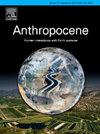Spatiotemporal variability of fluvial carbon components under different land use types in a mountainous karst region, Southwest China
IF 3.3
2区 地球科学
Q2 ENVIRONMENTAL SCIENCES
引用次数: 0
Abstract
Rivers export inorganic and organic carbon derived from various landscapes. Land use thus can significantly impact the spatiotemporal variations in river carbon species. However, the impact of land use, especially agricultural land, on riverine carbon species and dissolved organic matter (DOM) compositions in carbonate areas remains poorly explored. In this study, we collected water samples from a typical karst river in Southwest China, and analyzed the dissolved organic and inorganic (DOC and DIC) and particulate organic carbon (POC) concentrations, δ13CDIC, and DOM compositions. The DIC concentration and δ13CDIC value ranged from 7.9 to 41.4 mg L–1 and −11.2 to −7.4 ‰ in the wet season, and from 7.4 to 48.7 mg L–1 and −9.5 to −5.7 ‰ in the dry season, respectively. During the wet season, the tributaries from the catchments with high proportions of forest coverage have relatively low DIC concentrations, and negative δ13CDIC values, indicating the larger contribution of soil CO2. The forest-dominated group exhibited the highest proportions of humic-like C1 (21.1 ± 0.7 %). The cropland-dominated group displayed the highest proportions of protein-like C3 (44.6 ± 7.6 %), indicating the organic matter inputs from terrestrial and anthropogenic sources. The POC% and C/N ratio ranged from 0.1 % to 0.8 % and 1–16.6 in the wet season, respectively. The proportion of cropland is positively correlated with POC and C/N, indicating the loss of soil rich in organic matter in farmland. These results further highlighted that land use and biological processes have an important impact on carbon transportation in the karst rivers. Therefore, considering alterations in carbon component dynamics resulting from climate and land use changes is crucial for river ecosystem assessments and sustainable development.
西南山地喀斯特地区不同土地利用类型下河流碳组分的时空变异
河流输出来自不同景观的无机和有机碳。土地利用对河流碳的时空变化具有显著影响。然而,土地利用,特别是农业用地,对碳酸盐岩地区河流碳种类和溶解有机质(DOM)组成的影响尚未得到充分探讨。本研究采集了西南典型喀斯特河流的水样,分析了水体中溶解有机、无机(DOC、DIC)和颗粒有机碳(POC)浓度、δ13CDIC和DOM组成。雨季DIC浓度和δ13CDIC值分别为7.9 ~ 41.4 mg L-1和- 11.2 ~ - 7.4 ‰,旱季DIC浓度和δ13CDIC值分别为7.4 ~ 48.7 mg L-1和- 9.5 ~ - 5.7 ‰。在雨季,森林覆盖率高的流域的支流DIC浓度相对较低,δ13CDIC值为负,表明土壤CO2的贡献较大。森林优势组腐殖质样C1的比例最高(21.1 ± 0.7 %)。以农田为主的群落中蛋白质样C3的比例最高(44.6% ± 7.6 %),表明有机质输入来自陆源和人为来源。湿季POC%和C/N比值分别为0.1 % ~ 0.8 %和1 ~ 16.6。耕地比例与POC、C/N呈显著正相关,表明农田中富含有机质的土壤正在流失。这些结果进一步强调了土地利用和生物过程对喀斯特河流碳运输的重要影响。因此,考虑气候和土地利用变化导致的碳组分动态变化对河流生态系统评估和可持续发展至关重要。
本文章由计算机程序翻译,如有差异,请以英文原文为准。
求助全文
约1分钟内获得全文
求助全文
来源期刊

Anthropocene
Earth and Planetary Sciences-Earth and Planetary Sciences (miscellaneous)
CiteScore
6.30
自引率
0.00%
发文量
27
审稿时长
102 days
期刊介绍:
Anthropocene is an interdisciplinary journal that publishes peer-reviewed works addressing the nature, scale, and extent of interactions that people have with Earth processes and systems. The scope of the journal includes the significance of human activities in altering Earth’s landscapes, oceans, the atmosphere, cryosphere, and ecosystems over a range of time and space scales - from global phenomena over geologic eras to single isolated events - including the linkages, couplings, and feedbacks among physical, chemical, and biological components of Earth systems. The journal also addresses how such alterations can have profound effects on, and implications for, human society. As the scale and pace of human interactions with Earth systems have intensified in recent decades, understanding human-induced alterations in the past and present is critical to our ability to anticipate, mitigate, and adapt to changes in the future. The journal aims to provide a venue to focus research findings, discussions, and debates toward advancing predictive understanding of human interactions with Earth systems - one of the grand challenges of our time.
 求助内容:
求助内容: 应助结果提醒方式:
应助结果提醒方式:


